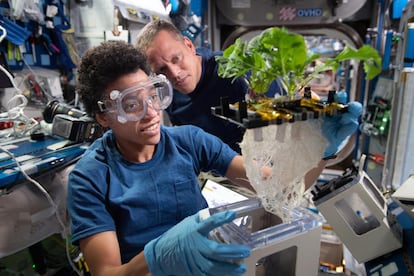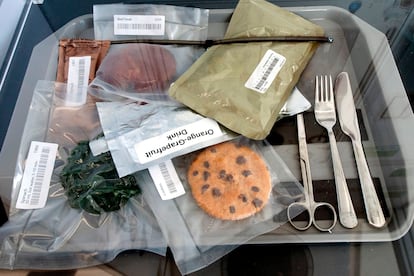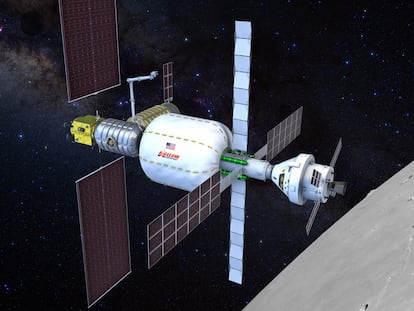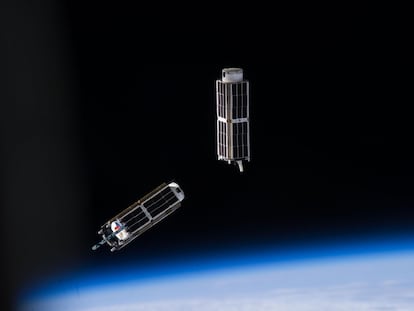Zero gravity and a lot of spice. That’s what it’s like to eat in space
Thousands of precautions must be taken before taking food into space. However, the first space crops are already being grown, and the first restaurant to collaborate with NASA is Spanish

Imagine this: you get into a spaceship, sit down and fasten your seat belt. 3, 2, 1... Lift-off, the spacecraft accelerates, shudders and 90 minutes later is already in space. Everything is dark and the only thing you hear is the voice of your crewmates. This is a long mission, for several days you will be 408 kilometers (253.5 miles) above the planet. Sleeping is not a problem (you’ll do it while you float), but what about eating?
To feast in space, you have to think about a lot of things before you can actually eat. It’s a marvelous feat of engineering up there, one that involves creativity and a lot of ingenuity to be able to enjoy a sandwich made with flour tortillas or a tasty dessert. And although the first space crops already exist, it wasn’t always that way. Technology has come a long way since 1961, when the first person had the opportunity to eat in space.
As with any other item to be loaded onto a spacecraft, the limitations on food are its weight and volume. Firstly, because the spacecraft has to accelerate sufficiently to take off, and secondly, because onboard space is limited. “On the International Space Station (ISS) which is, right now, the only permanently inhabited spacecraft, there is no refrigeration. That means there is no refrigerator or anything like that. The other complication is the zero gravity,” explains Eneko Axpe, PhD in Physics, researcher in gastrophysics, scientific collaborator with NASA and professor at the Basque Culinary Center.

Bread, a popular staple, cannot be taken into space. Breaking the bread would release thousands of tiny particles that could float into air filters or electronic devices. For that reason, flour tortillas are preferred. This is thanks to Rodolfo Neri Vela, the first Mexican to go into space, who ordered tortillas for his trip in 1985. All foodstuffs are developed based on these limitations, but without neglecting the astronauts’ caloric and protein requirements.
The beginnings of space food
In the past, missions were very short. They lasted a day at most. Yuri Gagarin was the first to experience a space meal, if you can call it that. Like toothpaste, his food was packaged in a tube. His lunch that day in 1961 was a kind of paste of ground beef and liver with vegetables. And since there would also be dessert, there was another tube that contained a chocolate sauce. “By the way, Gagarin was not an astronaut, he was a cosmonaut. Americans and Europeans are called astronauts, but the Soviets are called cosmonauts,” Axpe points out.
On his mission aboard Friendship 7, John Glenn was the second person to eat while orbiting planet Earth. The novelty on that occasion was a straw. NASA uploaded sugar tablets that were dissolved in water and thanks to the straw it was possible to drink the liquid. The toothpaste-style aluminum tube was also present during that meal, but this time it contained apple sauce.
“Lyophilization (freeze-drying), a technique widely used today in almost all Michelin-starred restaurants, was devised and designed by NASA. It is used to remove water to reduce the volume and weight of the product,” says Axpe. But you don’t have to go to a haute cuisine restaurant, if you’ve had instant coffee, you’ve tasted a freeze-dried product.
Extraterrestrial cooking
There is no kitchen on the ISS. “They [the astronauts] carry the products in a kind of envelope and inject them with water under pressure, which, by the way, is recycled and filtered from the astronauts’ sweat and urine,” Axpe says. Astronauts can choose a few products to take into space with them. They usually opt for fresh ingredients such as fruit and vegetables, but there is no way to preserve them in space, so they can only consume them during the first days of the mission.
Because of zero gravity, a percentage of our senses of smell and taste is lost, which makes the food less tasty. This is where hot sauces come to the rescue. “Astronauts put spice on everything, to make the food taste like something, at least,” Axpe says. There are astronauts who spend hundreds of days in space, and it takes its toll on them in multiple ways. Eneko Axpe came to the space agency after developing a mathematical model that predicted the bone deterioration of astronauts participating in long missions. Thanks to this, menus can be developed to prevent this deterioration. “Another thing that affects the astronauts on a psychological level is the absence of fresh edible products,” Axpe adds.
Friday Feasting! After the harvest, we got to taste red and green chile. Then we filled out surveys (got to have the data! 😁). Finally, I made my best space tacos yet: fajita beef, rehydrated tomatoes & artichokes, and HATCH CHILE! https://t.co/pzvS5A6z5u pic.twitter.com/fJ8yLZuhZS
— Megan McArthur (@Astro_Megan) October 29, 2021
Cultivating plants in space
NASA is looking to plant in space. Research is currently underway on the cultivation of microgreens. “These sprouts are very small and grow very fast, but at least they give the astronauts a sense of freshness, which is what they lack when they are in space,” says Axpe. On Earth we have the full spectrum of light (one of the factors responsible for crop growth), but in space we do not. After much research, NASA found that, using red and blue LEDs, it was enough to grow some plants outside the Earth.
One of the vegetables with the best chance of being grown in space is the potato, because it is a tuber that grows underground, meaning it is not exposed to the atmosphere, and it is also high in calories. The atmosphere in space is very different from that on Earth. There is already a project called Veggie that launched a space vegetable garden. In 2015 the first lettuce grown in space (a Red Romaine) was eaten, and last year the first space bell pepper was harvested.
Now, one of the problems that NASA is looking to solve is the astronauts’ protein intake. For this, the Azurmendi restaurant, owned by Spanish chef Eneko Atxa, is officially the first restaurant business to collaborate with NASA. They are working on a project that aims to use mycelium, which is basically the root of mushrooms. Axpe and Eneko Atxa see a great opportunity here. “The potato only has 2% protein, that’s when we came up with the idea of using mycelium, because it has between 9% and 45% protein, and it is also a food that can grow up to 40 millimeters a day, it grows very fast,” says Axpe.
Sign up for our weekly newsletter to get more English-language news coverage from EL PAÍS USA Edition
Tu suscripción se está usando en otro dispositivo
¿Quieres añadir otro usuario a tu suscripción?
Si continúas leyendo en este dispositivo, no se podrá leer en el otro.
FlechaTu suscripción se está usando en otro dispositivo y solo puedes acceder a EL PAÍS desde un dispositivo a la vez.
Si quieres compartir tu cuenta, cambia tu suscripción a la modalidad Premium, así podrás añadir otro usuario. Cada uno accederá con su propia cuenta de email, lo que os permitirá personalizar vuestra experiencia en EL PAÍS.
¿Tienes una suscripción de empresa? Accede aquí para contratar más cuentas.
En el caso de no saber quién está usando tu cuenta, te recomendamos cambiar tu contraseña aquí.
Si decides continuar compartiendo tu cuenta, este mensaje se mostrará en tu dispositivo y en el de la otra persona que está usando tu cuenta de forma indefinida, afectando a tu experiencia de lectura. Puedes consultar aquí los términos y condiciones de la suscripción digital.
More information
Archived In
Últimas noticias
NASA discovers Titan doesn’t have an ocean, but a ‘slushy ice layer’ that increases possibility of life
Innocence lost in the forest of the child soldiers: ‘Each leader of the armed group had his girls’
‘Fallout’ or how the world’s largest company turned an anti-capitalist apocalyptic Western into a phenomenon
From inflation to defending migrants: Eileen Higgins and Zohran Mamdani inaugurate the new Democratic resistance against Trump
Most viewed
- ‘El Limones’ and the growing union disguise of Mexican organized crime
- Christian Louboutin: ‘Young people don’t want to be like their parents. And if their parents wear sneakers, they’re going to look for something else’
- The low-cost creative revolution: How technology is making art accessible to everyone
- ‘We are dying’: Cuba sinks into a health crisis amid medicine shortages and misdiagnosis
- A mountaineer, accused of manslaughter for the death of his partner during a climb: He silenced his phone and refused a helicopter rescue










































